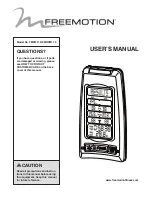
Section 6 — Effect Parameters
ASR-10 Musician’s Manual
6
Edit/Effects Parameters
REVERB DECAY TIME
DIFFUSION
HI FREQ DAMPING
See the descriptions under Hall Reverb.
ROTOR FAST
Range:
0 to 99
Determines the rate of the rotary speaker when in the “Fast” setting. The higher the value, the
faster the rate.
ROTOR SLOW
Range:
0 to 99
Determines the rate of the rotary speaker when in the “Slow” setting. ROTOR SLOW determines
the manual level for the rotary speaker rate when FAST-SLOW SWITCH= OFF, or when the
selected modulator is at zero output level. Again, the higher the value, the faster the rate.
ROTOR INERTIA
Range:
0 to 99
Determines how long it will take for the rotor effect to speed up and slow down after switching
from fast to slow or vice versa. Adjust this parameter to simulate the effect of the rotary speaker
gradually picking up speed.
FAST-SLOW SWITCH
Range:
see below
Determines how the rotary speaker will switch between slow and fast speeds. The behavior of
the switch accurately reflects an actual rotary speaker, taking time to speed up or slow down,
based on the value of the ROTOR INERTIA parameter above. Any effect modulator can act as
the FAST-SLOW SWITCH. How the modulators will switch the rotor speed fall into two
categories:
• WHEEL, PBEND, PRESS(ure), PEDAL, XCTRL, KBD, and VEL — These modulation sources
act like a switch to turn on or off the fast rotor speed. To reverse the polarity of the switch, set
ROTOR SLOW faster than ROTOR FAST.
• KEYDN, SUSTN, FSW-L, PATCH — These modulation sources toggle the rotor speed between
slow and fast. Every time the modulation source moves from zero in a positive direction, the
rotating speaker effect changes speeds from slow to fast or fast to slow.
DIST GAIN IN/OUT
In and Out Range: 0 to 99
The IN parameter determines the input signal gain into the amplifier simulation, creating a tube-
like overdrive.
The OUT parameter controls the output of the amplifier distortion. There is a (fixed) clean path in
parallel with the distortion. Therefore, to eliminate distortion, set this parameter to zero.
SPEAKER GAIN
Range:
0 to 99
Controls the level of the signal (distorted or not) applied to the rotary speaker. High gain will
simulate a broken speaker. Also use higher settings when using little or no distortion, because
distortion raises the signal level to the speaker.
DISTORTION FILTER
Range:
0 to 99
A three-pole, low pass filter following the amplifier simulation. This parameter controls the filter
cutoff resulting in a brighter sound (for higher values) or a darker sound (low values).
ROM-10 CHOR+REV+DDL
Chorus with digital delay and reverb. Assign a voice to BUS1 for Chorus and Reverb, BUS2 for
Reverb only, and BUS3 for Digital Delay (DDL).
















































